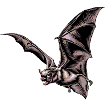Museum, University of Nebraska State
Molecular Systematics of the Fruit Bat, Artibeus jamaicensis: Origin of an Unusual Island Population
Document Type
Article
Date of this Version
5-1-1996
Citation
Journal of Mammalogy (1996) 77(2): 491-503.
Abstract
DNA sequences from mitochondrial tRNA genes, the light strand replication site, and a region of the 12s rRNA gene were used to test the hypothesis that the unusual Antillean island subspecies, Artibeus jamaicensis schwartzi, was derived from a South American origin. Parsimony and bootstraping analyses allied the mitochondrial genome in these bats with mitochondrial DNA (mtDNA) isolated from Artibeus planirostris living in French Guiana rather than with mtDNA isolated from Artibeus jamaicensis from the Antilles or Mexico. Although the tRNA sequences differed slightly, the 12s rRNA sequences were identical in mtDNA isolated from A. j. schwartzi on St. Vincent and A. planirostris from French Guiana. It is proposed that A. planirostris was an early arrival to the Antilles, and that it possibly reached the Greater Antilles. Genetic analyses of these island populations may shed light on gene flow, speciation, and even extinction processes in bats. In broader interspecific comparisons, it was noted that the 12s rRNA and cytochrome-b genes might evolve somewhat differently among different stenodermatine species, and it was hypothesized that this could affect systematic analyses. None of the mtDNA sequence data sup- ported the utility of the proposed genera Dermanura and Koopmania.



Comments
Copyright © 1996, American Society of Mammalogists. Used by permission.